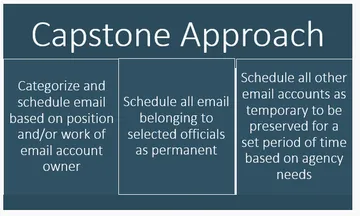Capstone update: A success story for long-term digital preservation of the US Government’s e-mail records
 Jason R. Baron
•
October 17, 2019
Jason R. Baron
•
October 17, 2019
This is the second installment of a three-part blog based on a webinar jointly hosted last month by Preservica and Deloitte entitled “Transition to Electronic Government: Practical Advice from the Field.” During the webinar I had the chance to highlight several US federal government initiatives that I believe should be of great interest to records managers and archivists practicing anywhere in the public sector.
Last month I covered the rapidly approaching digital preservation deadlines embedded in new guidance issued by the Office of Management and Budget and the National Archives and Records Administration (NARA). Here I wish briefly to note recent developments in email preservation using Capstone policies, in the context of the federal government’s larger framework for records management solutions and services.
An ongoing policy initiative is NARA’s Capstone approach to email, which I confess a special interest in given the high-profile aspect of email which has consumed the legal profession for the past 30 years (as well as the role I played in advocating for Capstone itself while at NARA). Capstone represents a sea-change in approaching email management: for agencies that elect to follow the policy, all email from designated senior executives (“Capstone officials”) is deemed permanent, with all other staffs’ substantive email deemed appropriate for preservation for seven (7) years. A General Records Schedule 6.1 sets out the more specific terms of the policy.

The good news on this front is that on the order of 200 federal agencies have adopted or are in the process of adopting Capstone policies for the management of email. In coming years, this translates into hundreds of thousands if not millions of email records and attachments being preserved in authorized digital formats for their eventual accessioning into NARA.
The impact of the adoption of Capstone is in my view potentially profound, both immediately and for the long term. Widespread agency adoption of Capstone policies means that email records from across the Federal government are potentially accessible under the Freedom of Information Act, subject of course to that Act’s exemptions where applicable. Moreover, the most senior officials’ email correspondence in participating agencies will also one day be available for the interested public to access at NARA. This is a boon to history and the makings of a great success story in enhancing long-term digital preservation of government records.
There are several state government initiatives that have adopted a “Capstone” outlook to managing email or making senior executives’ e-mail accessible. These include a Capstone Approach to Email Management adopted in North Carolina, as part of the TOMES (Transforming Online Mail with Embedded Semantics) multistate project;as well as a “Capstone Email Project” going on in Illinois making accessible records from Gov. Blogojaveich through the use of e-discovery search tools utilizing predictive coding.
On the webinar, I also noted that in 2014 NARA launched the Federal Electronic Records Modernization Initiative (or “FERMI”), representing an effort to provide a “government-wide, modern, cost-effective, standardized, and interoperable set of records management solutions and services to Federal agencies.” FERMI includes universal requirements for electronic records management as a baseline for agencies to use in acquiring commercial services from the marketplace.
FERMI also provides a section on use cases to help “tell stories” about electronic records management that agencies can use internally or with vendors. In April 2019 the first use cases were published that focus on capture, maintenance/use, disposal and transfer of electronic messages.
In short, Capstone and FERMI are two NARA initiatives that highlight the growing maturity of electronic recordkeeping in the US federal sector, including on issues involving long-term preservation.
To read last month’s first installment see here.
To view the full recording of the webinar “Transition to Electronic Government: Practical Advice from the Field,” please follow this link.




